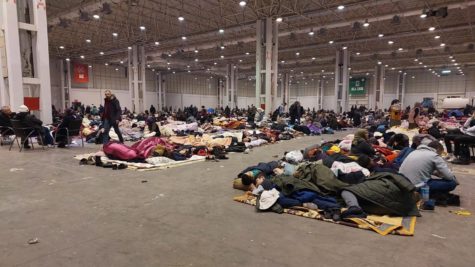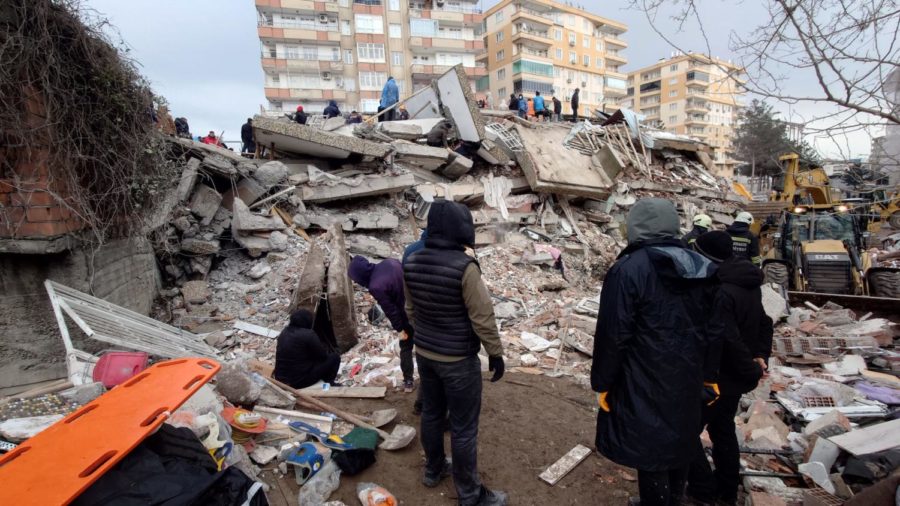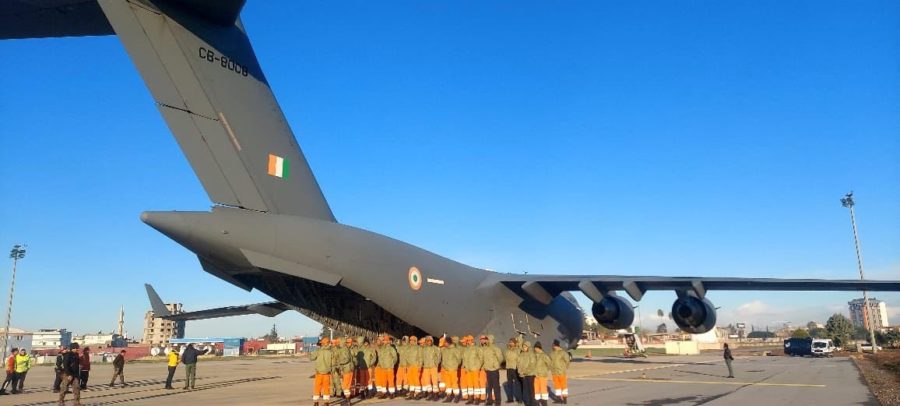Aftershocks Rattle Turkey And Syria: Earthquake Recovery Efforts Continue
Authorities issue emergency response plan after earthquake displaces many in Turkey and Syria.
VOA, Public domain, via Wikimedia Commons
Residents look at the rubble that was once their home in Diyarbakır, Turkey.
When many felt the ground shake violently beneath their feet, they knew right away what was happening. People ran for cover, desperate to avoid shattering glass and falling debris. Tragically, some were not able to escape and were trapped under rubble. When the shaking finally stopped, many in the area were now left to pick up the pieces and rebuild their homes in the wake of this devastating natural disaster.
On February 6th, 2023, at 4:17 TRT, a 7.8-magnitude earthquake struck southern Turkey and northern Syria, leaving tens of thousands dead and cities in ruins. The death toll in Turkey alone had reached a staggering 47,975. Meanwhile, data from the United Nations indicated that the death toll in Syria had surpassed 5,500. The earthquake was followed by over 100 aftershocks, including a 7.5-magnitude earthquake.
The earthquake caused many buildings to be left in ruins or were deemed unsafe which left hundreds of thousands of people exposed to harsh weather conditions without shelter. Many relief agencies have estimated that millions of people are in need of aid, with over 5.3 million individuals in Syria potentially losing their homes.
According to AFAD, the organization leading the rescue and relief efforts, a staggering 238,000 Turkish and international workers are involved in this monumental operation. Despite the valiant efforts of the rescue teams, time was not on their side, and the chances of finding more survivors diminished with each passing moment, leaving many to mourn the loss of loved ones and to face an uncertain future.
The Syrian Civil War, territorial division, and strained relations between the Syrian president, President Bashar al-Assad, and Western nations have complicated delivering aid to survivors in Syria. The United Nations launched a $397 million humanitarian appeal for Syria, but aid has been hindered by the damage sustained by the only U.N.-approved crossing into northwestern Syria. For the past several years, the UN has been delivering assistance to those in need in this conflict-ridden region through Turkey under the authority of a Security Council mandate. However, the organization’s ability to provide aid has been severely restricted by the fact that the UN is only permitted to use a single border crossing for this purpose. The Syrian government controls aid flowing through Damascus, the capital of Syria, making it difficult to reach opposition-held areas without permission. As a result, the UN’s ability to provide vital assistance to those in need has been significantly impacted, raising concerns about the humanitarian situation in this troubled region. Although some supplies have been received, rescue workers and doctors report that they are insufficient.
The failure of aid efforts in the opposition-held northwest region of Syria has been acknowledged by the United Nations’ top aid official, who expressed concern that people in the area feel abandoned. The White Helmets, a civil defense group operating in the region, have expressed frustration at the prospects of getting aid into the area without outside support. Due to many delays in receiving additional equipment and assistance, local rescue teams could only search 5% of the affected areas. Urgent appeals have been made by humanitarian organizations to deliver a significant amount of aid to all affected areas, with unrestricted access being essential to alleviate the suffering of those impacted by the crisis.
The decision by President Assad to approve the opening of two new border crossings from Turkey into the regions of northwest Syria is a significant development. For the first time since the start of the Syrian civil war in 2011, al-Assad has agreed to allow humanitarian aid to be delivered to these areas. This move by the Syrian government allows the United Nations to provide much-needed aid for a period of three months, which has been widely welcomed by humanitarian organizations.
CNN reported that amidst the devastation caused by the earthquake, a miraculous rescue took place in northern Syria, where a baby girl named Aya was found alive under the rubble of her five-story apartment building. The rescue workers found her still attached to her mother’s body by the umbilical cord, more than 10 hours after the deadly quake. Sadly, Aya is believed to be the only survivor in her immediate family. Following the rescue, Aya’s cousin immediately took her to the hospital, where she received treatment and her condition has since stabilized.
Turkey is located on the intersection of two major fault lines, the East Anatolian and North Anatolian fault zones, which makes it one of the most seismically active countries in the world. Over the last 120 years, the country has experienced more than 70 earthquakes with a magnitude of 6.5 or higher.
Since the country is prone to seismic activity, Turkey has taken steps to improve its building regulations since the devastating earthquake near Istanbul in 1999 that claimed over 17,000 lives. However, in a 2021 parliamentary report by the Chamber of Geological Engineers of Turkey, more than 7.8 million buildings constructed before 2000 are still at risk of damage in the event of an earthquake. Construction experts have expressed concern that the updated building codes for newer structures are not always followed by builders, putting residents at risk.
Many residents have reported that these regulations are often disregarded by builders looking to cut costs. Builders in Turkey have been known to construct buildings with more floors than what they are permitted to build. This practice is commonly referred to as “construction amnesties.” Critics argue that these buildings are now more susceptible to damage in earthquakes, as some builders use deceitful tactics to add extra stories, such as building them underground or hiding them.

To prove this, a university engineer, James Kaklamanos, Associate Professor of Civil Engineering at Merrimack College in Massachusetts, U.S. and his colleagues noted indications of inadequate steel reinforcements and low-quality concrete leading them to conclude that many buildings were susceptible to damage even from minor earthquakes. As a result, experts speculate that shoddy construction practices may have contributed to the high number of casualties.
Another tactic used by contractors was to pay private inspection companies to examine their buildings, incentivizing builders to hire cheap inspectors who would offer the least amount of scrutiny. This practice incentivized inspectors to cut corners, resulting in a lack of experience and expertise in the field. In 2019, the Turkish government reformed the system by assigning their own inspectors to buildings, eliminating this problem.
In the past, it was challenging for the authorities to take action against these illegal practices. However, recent reports suggest that the situation is changing. There have been instances of contractors attempting to flee the country, only to be caught by the authorities at the Istanbul airport.
The Turkish government has accused 564 contractors and builders of being involved in the construction of substandard or collapsed structures. Of these individuals, 160 have been detained and are awaiting trial, while 175 are on probation. Additionally, dozens more have been issued arrest warrants in connection with their alleged involvement.
For instance, in Antakya, a single contractor named Omer Cihan was hit with 51 lawsuits by Ebru Ulas and her husband, Gorkem, due to violations of building codes in at least seven buildings. Experts found problems with three of these structures, such as the Kule Apartments which later collapsed during the earthqake. Mr. Cihan was convicted by a judge for violating construction regulations in his buildings and was sentenced to one year in prison, but later reduced to a fine of approximately $650. Recently, Turkish authorities arrested Mr. Cihan, who claimed during his testimony that he had conducted all required inspections and was unaware of the reason for the building’s collapse.
Although some of the individuals detained following the earthquake were linked to political parties, such as the ruling party and the opposition, it is uncertain whether their political affiliations influenced their business practices. Those arrested in connection with the Isias Hotel, where the Turkish-Cypriot volleyball team tragically lost their lives, were affiliated with both sides of Turkey’s political spectrum.
The impact of the earthquakes has not been limited to Turkey and Syria alone. The tragedy also touched the community of Northern Cyprus when a school sports team from the Gazimağusa Turkish Maarif College lost their lives in Adiyaman. The group was in Adiyaman to participate in a school volleyball tournament. The team was composed of 24 Turkish Cypriot students, aged between 11 to 14 years, from both the girls’ and boys’ school volleyball teams. In addition to the students, four teachers, two trainers, and five parents who were accompanying the group perished when the hotel they were staying in, Isias Hotel, collapsed during the earthquake. Tragically, out of the 39 individuals, only one teacher and three parents were rescued.
Following the collapse of the Isias Hotel, authorities arrested four people, including the hotel owner. Investigations revealed signs of substandard design, use of low-quality materials, and failure to adhere to safety protocols. The education unions have since added their voices to the growing demands for accountability and justice in the aftermath of the tragedy.
Cemal Gokce, a former president of Turkey’s Chamber of Civil Engineers, has attributed the increased risk of earthquake damage to cities in Turkey to the lenient regulatory atmosphere created by President Recep Tayyip Erdogan’s government and his ruling Justice and Development Party. He said, “The government is trying to avoid responsibility by dumping it onto engineers and architects. “But the main culprit is the government because they put profits over the public interest.”
Cemal Gokce, a former president of Turkey’s Chamber of Civil Engineers, has attributed the increased risk of earthquake damage to cities in Turkey to the lenient regulatory atmosphere created by President Recep Tayyip Erdogan’s government and his ruling Justice and Development Party.
Ellena Wang is a News Editor for 'The Science Survey.' Journalism appeals to Ellena since it is a method that enables journalists to inform the reader...












